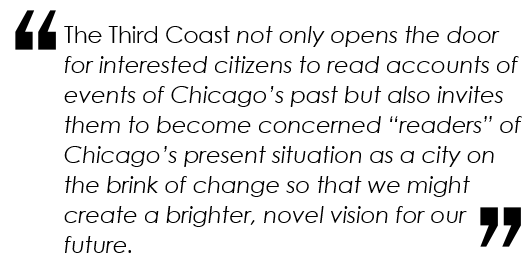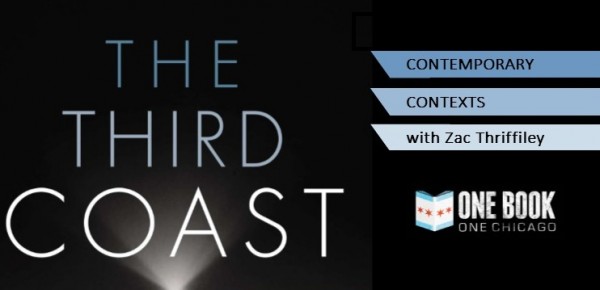Ex Libris’s Zac Thriffiley continues his ongoing column covering this year’s One Book, One Chicago selection, Thomas Dyja’s The Third Coast. This month Thriffiley takes a hard look at issues of race and injustice that haunt Chicago’s history and continue to importantly shape its future – a future reflected in the goals of One Book, One Chicago.
From Emmett Till to Laquan McDonald:
Chicago as a Catalyst for the Civil Rights Movement
Thomas Dyja was only four years old when, in 1966, Dr. Martin Luther King Jr. began renting an apartment on Chicago’s West Side as a sign of his commitment to the Chicago Freedom Movement, an ardent civil rights campaign designed to confront the city’s white leaders over issues facing urban black communities. The episode from that summer that Dyja remembers most clearly, though – and the one he recounted to a modest group of DePaul students and faculty last November – illustrates just how resistant white Chicagoans were to Dr. King’s proposed reforms. After 700 supporters of the movement had gathered to protest housing segregation near Marquette Park, a stone flew from a crowd of jeering white residents and struck Dr. King on the head, sending him to his knees. As the reverend struggled to regain his footing, an ominous atmosphere of hatred turned feelings into actions, and more rocks, glass bottles, and debris rained down upon the protestors. This outburst of violence prompted Dr. King to remark, “I have seen many demonstrations in the South, but I have never seen anything so hostile and so hateful as I’ve seen here today.”
 However, as Dyja’s book The Third Coast reveals, such demonstrations of hostility towards a black community seeking a new, better life had become an almost daily occurrence over the twenty years leading up to Dr. King’s summer marches. In 1946, Dr. Eugene Cooper and his wife were harassed by a crowd of nearly two thousand white residents who opposed the family’s move into the Park Manor neighborhood. The Coopers sold their house just three days later. The following year, “five thousand whites rioted against the first eight black families in Fernwood Park, smashing windows, attacking cars, and pulling blacks off streetcars.” Riots in response to integration would occur throughout the late 40’s and 50’s; the City Council’s response to this crisis exemplifies how racism had become a part of the city’s very infrastructure. In 1950, the council rejected the Chicago Housing Association’s proposal that would place public housing throughout the city and instead suggested a “compromise” plan that restricted public housing to black neighborhoods. According to Dyja, “an exasperated federal government forced the CHA to accept… forever poisoning open housing and integration in Chicago.”
However, as Dyja’s book The Third Coast reveals, such demonstrations of hostility towards a black community seeking a new, better life had become an almost daily occurrence over the twenty years leading up to Dr. King’s summer marches. In 1946, Dr. Eugene Cooper and his wife were harassed by a crowd of nearly two thousand white residents who opposed the family’s move into the Park Manor neighborhood. The Coopers sold their house just three days later. The following year, “five thousand whites rioted against the first eight black families in Fernwood Park, smashing windows, attacking cars, and pulling blacks off streetcars.” Riots in response to integration would occur throughout the late 40’s and 50’s; the City Council’s response to this crisis exemplifies how racism had become a part of the city’s very infrastructure. In 1950, the council rejected the Chicago Housing Association’s proposal that would place public housing throughout the city and instead suggested a “compromise” plan that restricted public housing to black neighborhoods. According to Dyja, “an exasperated federal government forced the CHA to accept… forever poisoning open housing and integration in Chicago.”

According to The Third Coast, though, the watershed moment for Chicago’s black communities as well as the emotional climax of Dyja’s narrative is the death and homecoming of Emmett Till. Emmett, who had been living in Chicago with his mother, Mamie, had gone to Mississippi in August of 1955 to visit his Uncle Mose. After only a week in Money, Mississippi, two white men, Roy Bryant and J.W. Milam, came in the middle of the night to Mose’s house, kidnapped Emmett, and proceeded to beat the fourteen-year-old boy for hours before shooting him in the head and throwing his body, weighted down with a cotton gin fan, into a river. Emmett’s alleged crime: whistling at a white woman. Once Emmett’s body was recovered, arrangements were made to send his remains back to his mother in Chicago in a sealed coffin. In defiance of these arrangements and in defiance of a nation that wanted the burial to take place as quietly as possible, Mamie brought a photographer to the funeral home, threw open the casket, and unveiled the mutilated corpse of her only son. The popular black magazine Jet ran the photos of Emmett’s body just five days later, and “the impact was immediate and profound.” The photos continued to circulate widely, and their publication acted as “a catalyzing moment” for civil rights organizations throughout the nation serving as an inspiration for Rosa Parks just two months later when she refused to give up her seat on a Montgomery bus. With this unprecedented event in the distribution of mass media, Chicago witnessed the birth of a cohesive civil rights movement.
In some ways, this narrative repeated itself just last year. Sandra Bland, a black woman from the suburbs of Chicago, was found hanged in a jail cell in Texas after her arrest by state trooper Brian Encinia. Bland’s story incited outrage among black communities when official dashcam footage released by authorities showed Encinia forcing Bland from her car and pinning her to the ground without any explanation as to why she was under arrest. Bland’s arrest, if not her death, became another example of an increasingly visible trend of excessive police force used against African-Americans. Despite Bland’s connection to Chicago, the city did not find itself brought into a national conversation on police violence until a video of the shooting of Laquan McDonald by Chicago Police Officer Jason Van Dyke was released in November of 2015, nearly thirteen months after the original shooting had taken place. Dashcam video shows Van Dyke firing sixteen shots at Laquan, even after the seventeen-year-old had fallen to the ground.

 In context with the lynching of Emmett Till, the deaths of Sandra Bland and Laquan McDonald – to say nothing of Michael Brown, Eric Garner, Freddie Gray, and the names of countless others who have died at the hands of law enforcement – serve to remind Chicagoans, and Americans as a whole, of a larger civil rights issue that authorities are reluctant to address. Dashcam videos of shootings have replaced photos of violence such as the ones published in Jet, but their power to catalyze a movement remains the same. Like the thousands who lined up to pay their respects Emmett Till, hundreds descended upon Michigan Avenue and shut down the retail capital of the city on the busiest shopping day of the year, a clear indication that a new generation of civil rights protestors are more than willing to take up the mantle of Dr. King. As Dyja proclaimed during his talk at DePaul just last year, “The history of black Chicago is the history of Chicago.” Subsequently, the future of black Chicago is the future of Chicago. Dyja’s quote points toward the vision of a unified, aware and engaged Chicago that the One Book, One Chicago program seeks to achieve every year through the books it encourages the city’s residents to read. The Third Coast not only opens the door for interested citizens to read accounts of events of Chicago’s past but also invites them to become concerned “readers” of Chicago’s present situation as a city on the brink of change so that we might create a brighter, novel vision for our future.
In context with the lynching of Emmett Till, the deaths of Sandra Bland and Laquan McDonald – to say nothing of Michael Brown, Eric Garner, Freddie Gray, and the names of countless others who have died at the hands of law enforcement – serve to remind Chicagoans, and Americans as a whole, of a larger civil rights issue that authorities are reluctant to address. Dashcam videos of shootings have replaced photos of violence such as the ones published in Jet, but their power to catalyze a movement remains the same. Like the thousands who lined up to pay their respects Emmett Till, hundreds descended upon Michigan Avenue and shut down the retail capital of the city on the busiest shopping day of the year, a clear indication that a new generation of civil rights protestors are more than willing to take up the mantle of Dr. King. As Dyja proclaimed during his talk at DePaul just last year, “The history of black Chicago is the history of Chicago.” Subsequently, the future of black Chicago is the future of Chicago. Dyja’s quote points toward the vision of a unified, aware and engaged Chicago that the One Book, One Chicago program seeks to achieve every year through the books it encourages the city’s residents to read. The Third Coast not only opens the door for interested citizens to read accounts of events of Chicago’s past but also invites them to become concerned “readers” of Chicago’s present situation as a city on the brink of change so that we might create a brighter, novel vision for our future.
-Zac Thriffiley, MAE
Find out more about OBOC and their upcoming events here.
Or pick up a copy of The Third Coast yourself here.
